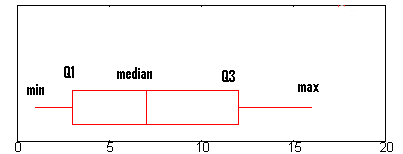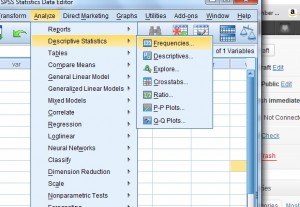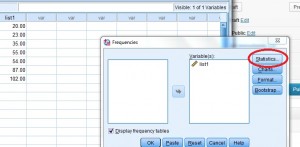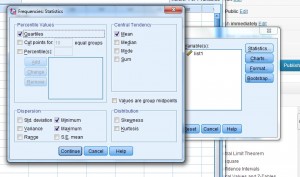Now Read the Following Data Into R Chegg
How to detect a five-number summary in statistics
Contents:
- Find a Five-Number Summary by Paw
- TI 89 Instructions
- SPSS Instructions
- 5 number summary in Excel (new window)
How to find a 5-number summary in statistics: Overview
Watch the video for an case of how to detect a 5 number summary for an odd set of numbers:
Can't run across the video? Click here.
This second short video shows what to exercise if y'all take an even set up of numbers:
Tin't see the video? Click here.

The 5 number summary includes 5 items:
- The minimum.
- Q1 (the first quartile, or the 25% marker).
- The median.
- Q3 (the 3rd quartile, or the 75% marker).
- The maximum.
The five number summary gives you lot a rough idea about what your data fix looks like. for instance, you'll take your lowest value (the minimum) and the highest value (the maximum). Although it's useful in itself, the master reason you'll want to detect a v-number summary is to observe more useful statistics, like the interquartile range, sometimes called the middle 50.
Demand help? Bank check out our tutoring page!
How to Discover a 5-Number Summary: Steps
- Footstep 1: Put your numbers in ascending order (from smallest to largest). For this detail information fix, the club is:
Example: 1, 2, 5, 6, 7, nine, 12, fifteen, 18, nineteen, 27. - Step 2: Discover the minimum and maximum for your information set. Now that your numbers are in order, this should be piece of cake to spot.
In the example in footstep one, the minimum (the smallest number) is i and the maximum (the largest number) is 27. - Footstep iii: Find the median. The median is the middle number. If you aren't sure how to find the median, meet: How to observe the mean style and median.
- Step iv: Place parentheses around the numbers above and below the median.
(This is non technically necessary, but it makes Q1 and Q3 easier to find).
(one, 2, 5, six, 7), 9, (12, xv, xviii, 19, 27). - Step 5: Find Q1 and Q3. Q1 can be thought of every bit a median in the lower one-half of the information, and Q3 can be thought of as a median for the upper one-half of information.
(1, two, v, six, seven), 9, ( 12, xv,18,19,27). - Step 6: Write down your summary found in the to a higher place steps.
minimum = 1, Q1 = v, median = 9, Q3 = 18, and maximum = 27.
That'south it!
When the Summary doesn't exist
Sometimes, information technology'southward incommunicable to find a v-number summary. In order for the v numbers to exist, your information set must meet these two requirements:
- Your data must be univariate. In other words, the data must be a single variable. For case, this list of weights is one variable: 120, 100, 130, 145. If you have a list of ages and you want to compare the ages to weights, it becomes bivariate information (2 variables). For example: age 1 (25 pounds), v (60 pounds), xv (129 pounds). The matching pairs makes information technology impossible to find a five number summary.
- Your data must be ordinal, interval, or ratio.
Like the caption? Check out the Practically Cheating Statistics Handbook, which has hundreds more step-by-footstep solutions, just like this one!
Back to Top
Box and whisker nautical chart
A box and whiskers chart is a visual representation of the summary.

Box Plot / Find a Five-Number Summary on the TI 89

A left skewed boxplot, showing a long left whisker. Image: SHU.EDU
When you lot create a box and whiskers chart on the TI-89, the TI-89 will automatically summate the five number summary for you.
Instance problem: Create a box and whiskers chart and find the five number summary for the post-obit data: 200, 350, 300, 350, and 400.
Step 1: Create a new folder called "Box." From the Abode screen, press F4 and curlicue down to NewFold (selection B). Printing ENTER.
Stride 2: Press second Alpha ( – x to spell B O 10 and press ENTER.
Stride three: Press APPS, and so gyre down to Stats/List Editor. Press ENTER twice.
Stride 4: Press the downwards arrow key to get to the first line of the list. Enter your data into list1. Follow each entry with a comma: 200, 350, 300, 350, 400.
Step five: Press F2 then one to enter Plot Setup.
Footstep 6: Press F1, right arrow, and v to select mod box plot.
Step vii: Arrow down to Mark and select box.
Footstep 8: Pointer down and enter B O X (using the alphanumeric keypad) in the x. Press ENTER.
Step 9: Read the boxplot. Press F3 and use the left and right cursors to discover Min(200), Q1(250), Med(325), Q3(400), and Max(500).
That's information technology!
Tip: if you desire to alter the binder dorsum to MAIN, press MODES, ringlet down to Current Binder. Press right key, so press i ENTER.
TipIf you get the error bulletin undefined variable, information technology tin exist a frustrating process to endeavour and solve the problem. Clearing the memory *may* assistance, but an easier mode to get the box plot to graph is to enter the data into "listing one" in the Listing Editor and and so type "list 1" as your "x" when defining the box plot.
Lost your guidebook? You can download a new ane from the TI website here.
Back to Top
Discover a 5 Number Summary in SPSS
Calculating the five number summary is pretty straightforward if you have a small information set, but for larger data sets — which you will typically work with in SPSS — the chore can be impossibly tedious. That'due south where software similar SPSS comes in handy — tasks that would sometimes have hours past paw can be calculated in a fraction of a second. The SPSS five number summary is calculated with the "Frequencies" tool.
Sentinel the video for the steps:
Can't meet the video? Click hither.
Stride 1: Open up a new data sheet and type your data into a column (or several columns). To open a new information sheet, click "File" in the toolbar, and so click "new" then click "Information." Make sure you type your data without spaces (in other words, don't go out empty rows).
Pace 2: Click "Analyze," then click "Descriptive Statistics" and and so click "Frequencies" to open the Frequencies dialog box.

The five number summary in SPSS is calculated through the Frequency menu.
Step three: Click a variable proper name (or several if yous accept entered your data into multiple columns) and then click the central arrow to movement them to the Variable(due south) list box. Note that SPSS uses the term "Variables," only all information technology really means is the cavalcade header name. Y'all can change this name by clicking the "Variables" view button at the bottom of the sheet.
Step 4: Click "Statistics" to open the Statistics dialog box.

Step 5: Check "Quartiles," "median," "minimum" and "maximum" and and so click "Go on."

Stride 6: Click "OK". The SPSS five number summary is calculated and the results are returned in a new window.
Annotation: SPSS lists the first quartile (Q1) as the 25th percentile in the results window, and the third quartile (Q3) is listed as the 75th percentile.
Back to Peak
Check out our YouTube channel for more stats help and tips.
References
Larry Gonick. The Cartoon Guide to Statistics, 1993
David C. Hoaglin, Frederick Mosteller and John W. Tukey. "Understanding robust and exploratory data analysis". Wiley, 1983.
---------------------------------------------------------------------------
Demand aid with a homework or test question? With Chegg Written report, you lot can go stride-by-step solutions to your questions from an expert in the field. Your first 30 minutes with a Chegg tutor is complimentary!
Comments? Need to post a correction? Please post a comment on our Facebook page .
Source: https://www.statisticshowto.com/statistics-basics/how-to-find-a-five-number-summary-in-statistics/
0 Response to "Now Read the Following Data Into R Chegg"
Post a Comment